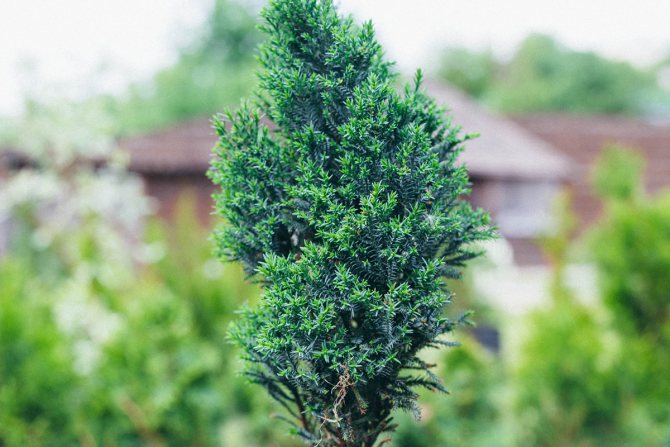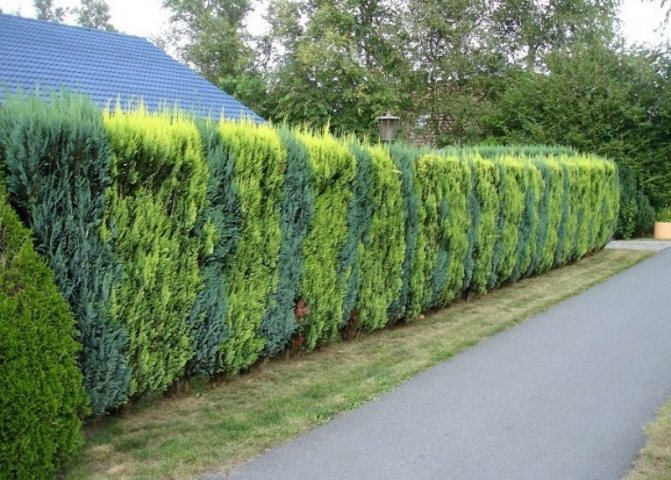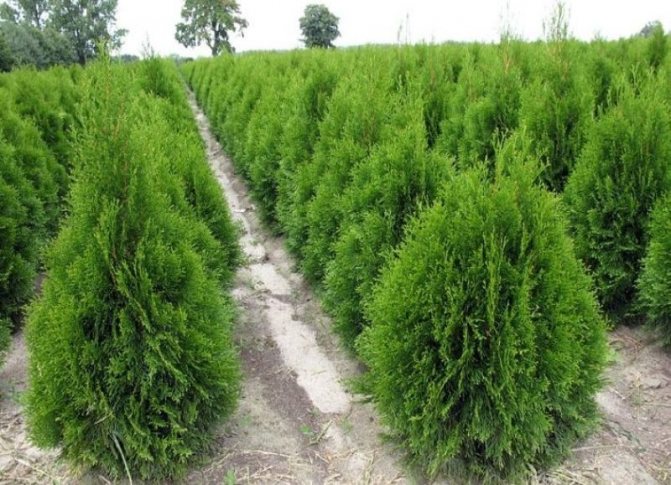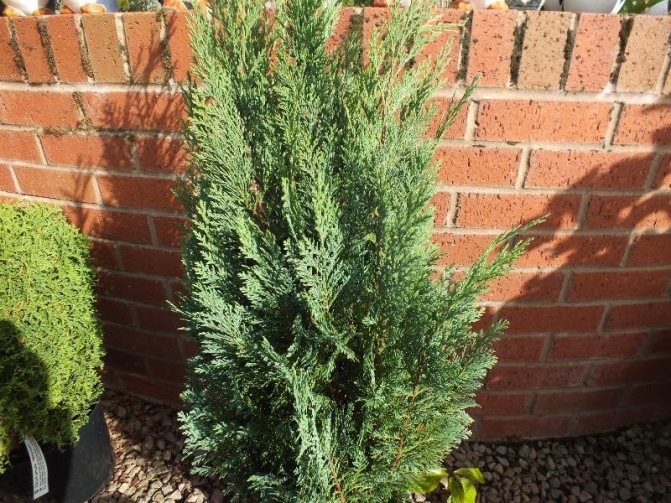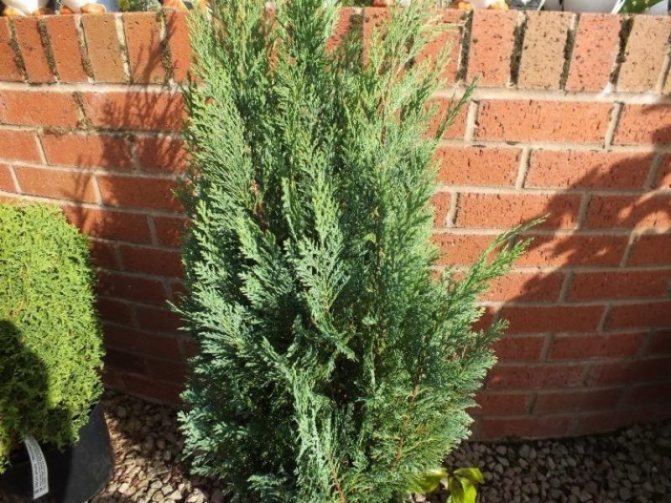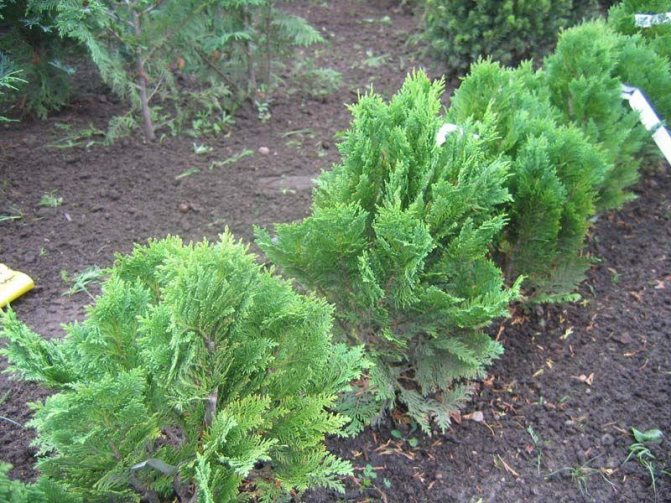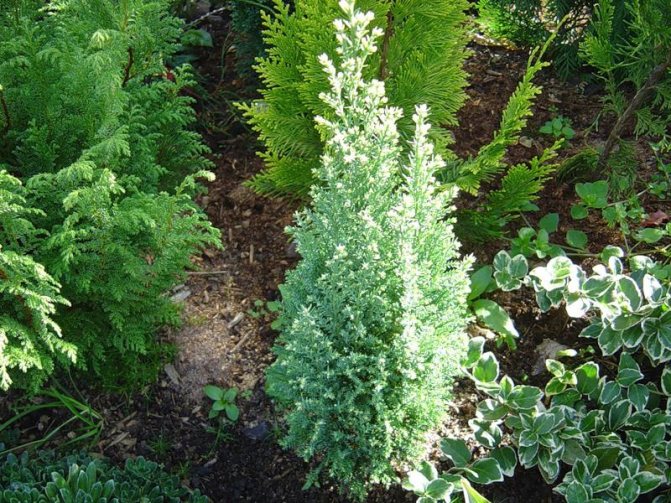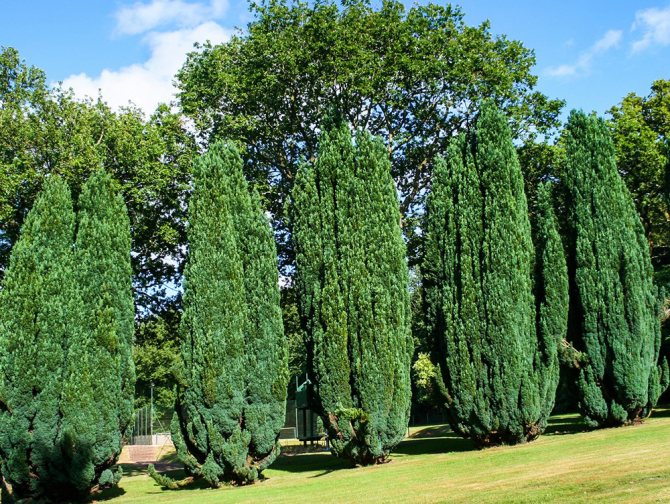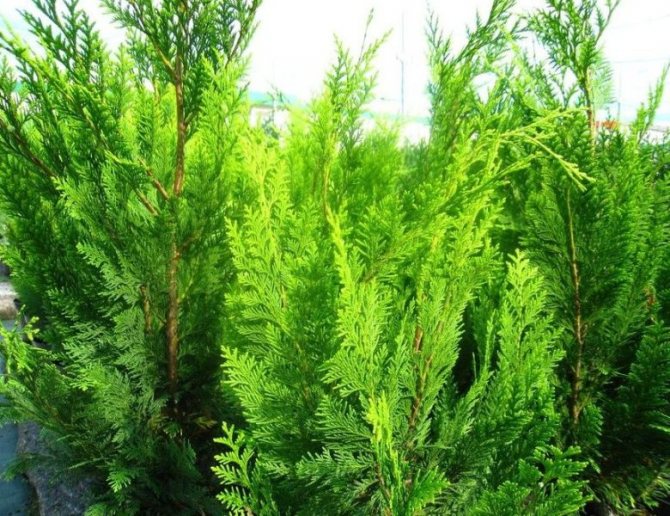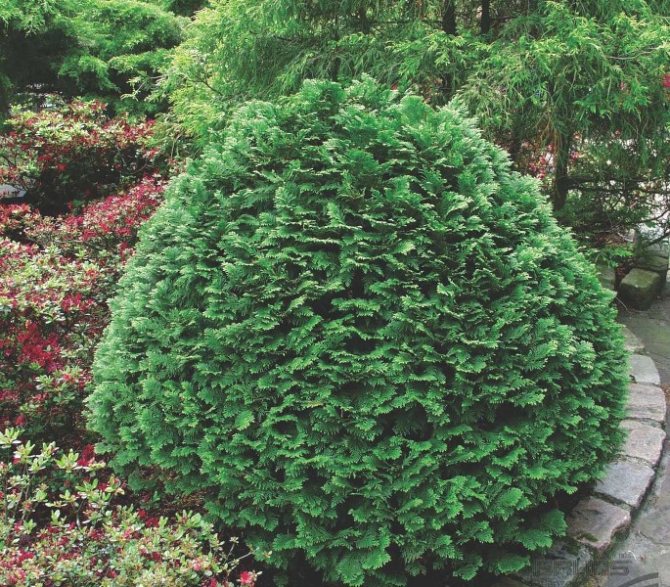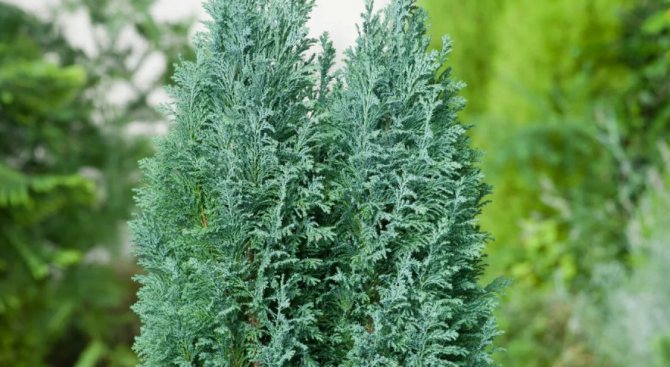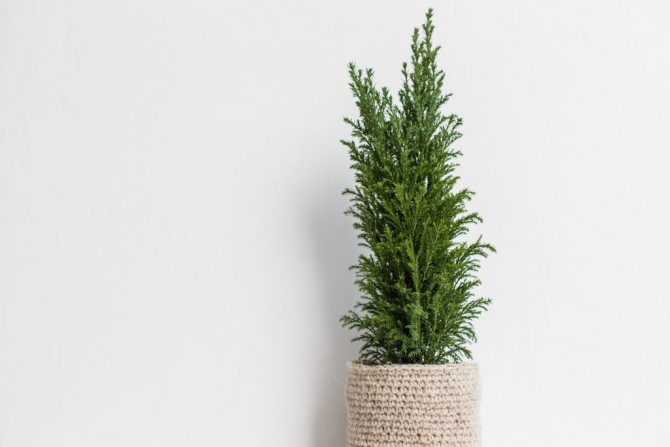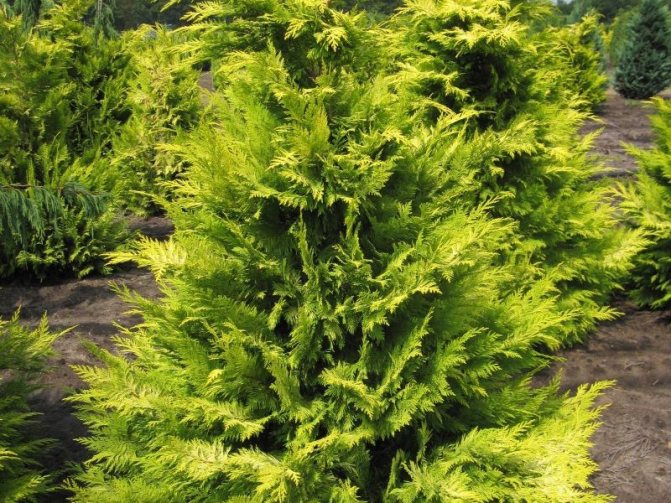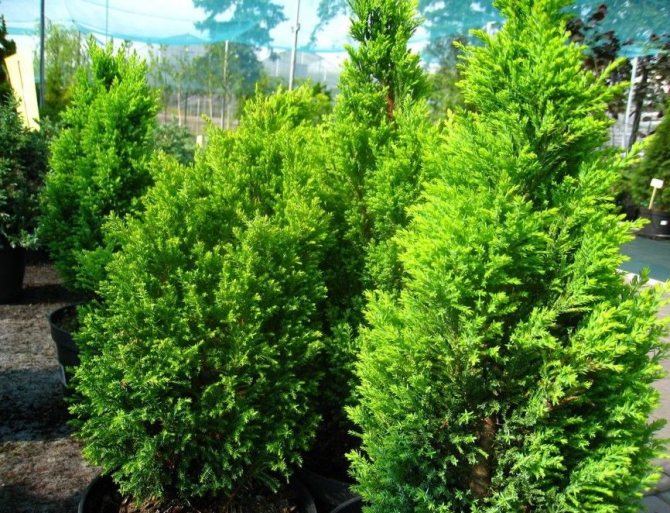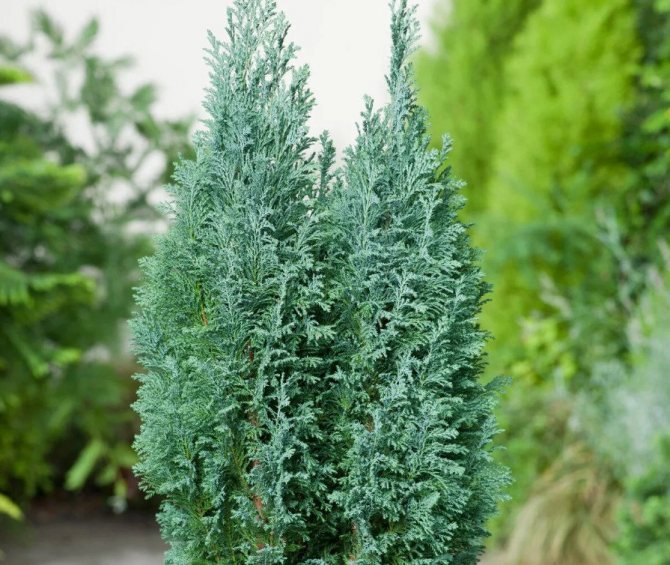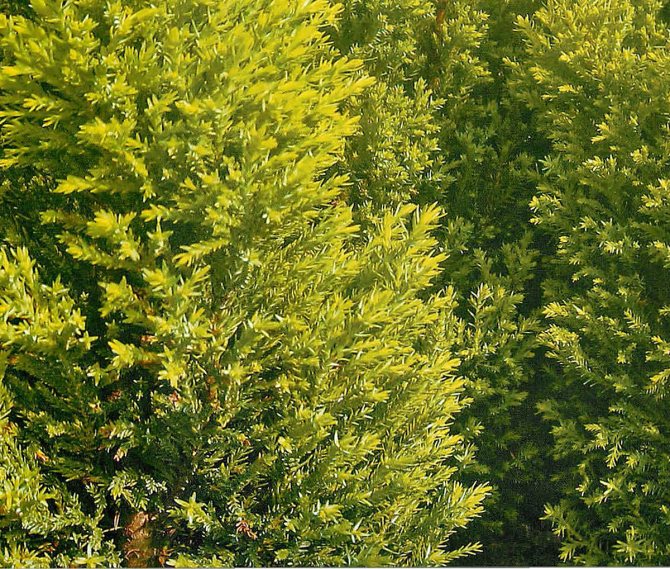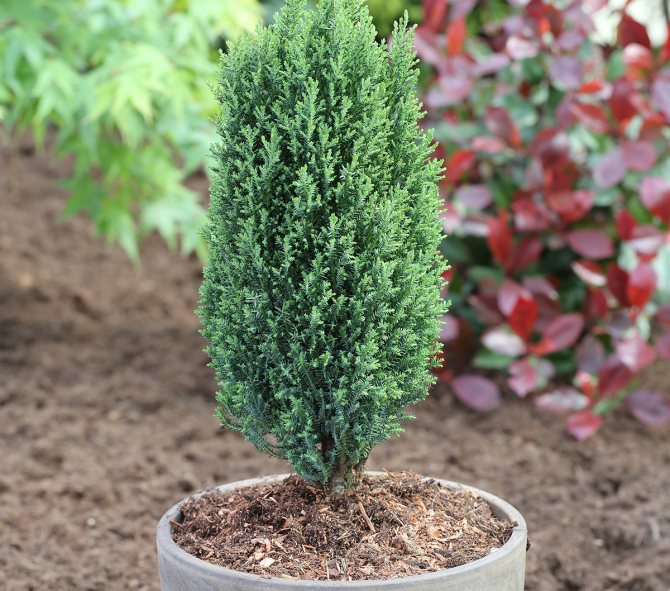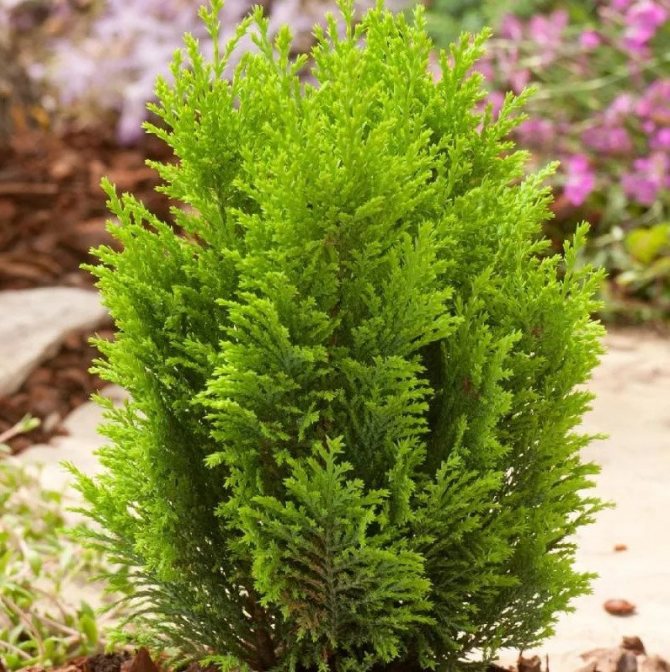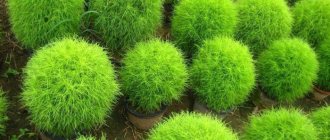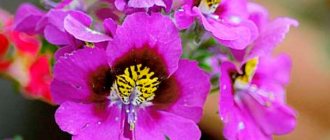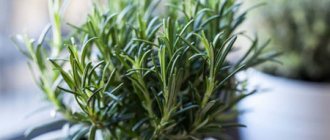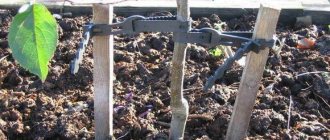Lawson's cypress trees these are some of the most beautiful conifers. There are many interesting species that differ in cut (conical, regular, spherical) and in the color of the shoots and scaly bark: it can be golden yellow, bluish, gray-green, light green. They look beautiful planted one at a time in a separate area or in groups with other conifers. However, it is worth knowing that this plant is difficult to grow and demanding to care for.
Description of the features of the Elwoodi cypress
Lawson's cypress Elwoodi originally grew on the mountain slopes of North America and in the eastern strip of Asia.
- It is an evergreen tree reaching a height of about 3.5 m.
- The growth of the tree is about 5 (in rare cases, 10) cm per year. Growth is slow, like in the Canadian conic spruce, so you need to be patient to grow an adult plant.
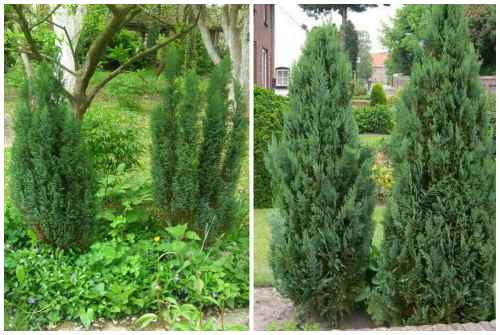
- Even at the age of 10 years, the height of the plant will not exceed one and a half meters.
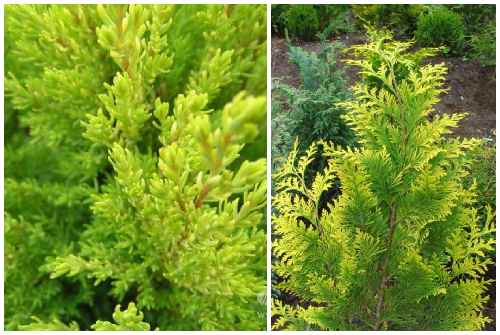

- As you can see in the photo, the crown is shaped like a wide cone with a diameter of 1-1.2 m with vertical, tightly closed shoots.
- Young trees have needle-like leaves, which distinguishes Elwoodi cypress from other conifers.
- You can buy a cypress tree both in a garden store and on the Internet. The price depends on the age and growth of the plant. The cost of an 80 cm Elwoodi seedling is 350 rubles.


Botanical description of the plant
In nature, Lawson's cypress is found in some regions of the United States, as well as in Japan and Taiwan. In all these countries, the wood of this plant is very highly valued, and in Japan it is customary to build temples from it.
Note: The culture's Latin name is Chamaecyparis, although most gardeners prefer to use the simpler name of Lawson.
Under natural conditions, the height of an adult Lawson cypress can reach 40 meters, although in gardens it rarely grows more than three meters. The relatively small size and compact crown of the crop explains why it is often used for landscaping. In addition, the plant has high frost resistance and is suitable for growing in all climatic regions (Figure 2).
Among other botanical features of the coniferous tree, it is worth highlighting:
- The trunk is straight and strong, covered with brown or grayish bark.
- The crown is formed directly from the trunk. It has a natural tapered shape and does not need additional trimming.
- The needles are in most cases dark green, but their lower part is colored gray.
- The branches are flat and sagging, making adult specimens look very exotic. In addition, the evergreen scaly needles that fit tightly to the branches give the tree a very attractive appearance.
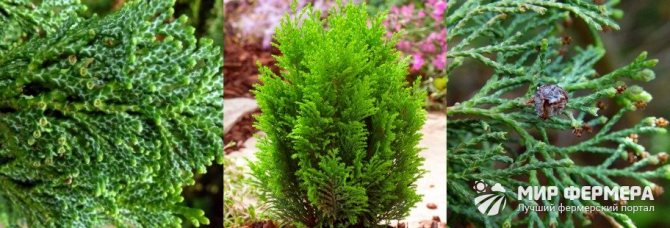

Figure 2. Externally, the culture differs from other conifers
Over time, the cypress shoots are covered with small cones. They crack when opened, and inside are seeds that can be used for propagation.
Elwoodi cypress care at home
Home care for Elwoodi cypress is quite simple, so the plant can be safely started even by novice gardeners.
- Location. A little shaded places are more suitable for the tree.In the summer heat, the crown must be sprayed, but waterlogging of the soil must not be allowed.
- Lighting. It is worth choosing shady areas for placement. The plant reacts negatively to direct rays of the sun, as a result of their exposure to the leaves, burns may appear. The best place for a pot is a window facing north, or a glazed loggia with protective windows. Absolute darkness must not be allowed, otherwise the needles may change color.


Important! When it gets cold, the tree prefers diffused light.
- The temperature is better reduced. In the summertime, not higher than 15 degrees, and in winter, not lower than 10.
- Humidity should also be increased. The plant does not like dry and hot places. The house reacts poorly to the inclusion and active operation of heating devices, to their close placement. That is why in winter the pot should be removed away from the radiator, and in summer it should be placed in the garden in shaded areas.


- Watering. The tree loves water. In summer and spring, he needs frequent watering so that the substrate does not dry out. But an excessive amount of water can negatively affect the condition of the plant, so it is better to observe the measure in watering. During autumn and winter, watering should be reduced, it is done only when the topsoil is dry.
Interesting! The cypress reacts very well to this trick: freeze the water, then spread the ice cubes around the tree. This will help moisturize the soil and air.


- Top dressing. The period for fertilizing is from late spring to mid-October with a frequency of 1 time in 14 days. It is better not to feed in winter.
Important! The dose of fertilizers should be halved from those indicated on the package.
- Pruning. It is best to start pruning old and dry branches in March. At the same time, you can also arrange a crown. Often it is given the appearance of an elongated cone. You can remove no more than 1/3 of the total foliage at a time. Bare branches should not be left as they will dry out soon. Do pruning only one year after planting.
- Priming. Elwood prefers drained, loose soil, so when planting it should not be deeply deepened, because this can lead to the death of the tree. The land should be composed of peat, turf, sand and leafy soil (1/1/1/2).


Appearance
Lawson's cypress trees growing in nature can reach 75 m in height, however, in our climatic conditions they usually do not exceed 20 m in height, and most of the cultivated varieties are even lower (2-3 m in height). Cypress trees form a dense, very dense, rather narrow, conical crown. The tops are tight, raised, numerous branches grow from them. Shoots are covered with brownish-orange bark, which peels off in longitudinal pieces. Lawson cypress trees, grown separately and sufficiently lit, are evenly ramified from the ground. When they are heavily shaded, they can go bald on the shaded side.
Lawson's cypress trees have a green scaly shell, which is covered with a bluish or silvery, waxy bloom. The scales are densely arranged and closely adjacent to each other, densely covering all the shoots and, in fact, covering them.
Lawson cypress plants are monoecious, heterosexual, bloom in March-April. The male flowers grow at the ends of the branches and are purplish red. Cones are small (0.8 cm), almost spherical, initially green, as they ripen, they acquire a light brown color and are covered with a waxy, pale blue bloom. They ripen in September, open, and winged seeds fly out of them.
Reproduction of cypress Elwoodi
Plant propagation occurs in the following ways:
- seeds;
- taps;
- by cuttings.
In the first case, wild crops are taken. The germination capacity of such seeds lasts about 15 years. Seed planting takes place in winter according to the following scheme:
- Before planting, the seeds undergo a growth-accelerating stratification procedure.
- They are seated in containers with loosened soil, and taken out into the street, covered with a layer of snow and left until spring.
- In spring, containers are brought into heat and warmed up until shoots appear. Young growth is systematically watered and, if necessary, transplanted.
- When warmth comes, the pots are taken out into fresh air in places without drafts.
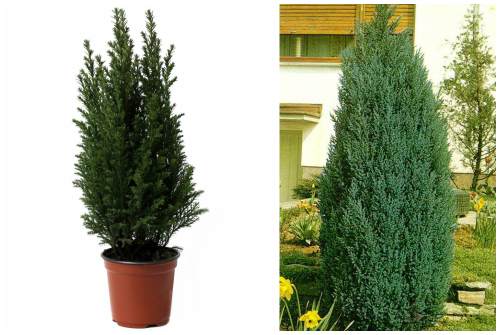

The grafting method is as follows:
Cuttings are taken from lateral shoots at the beginning of spring, no more than 15 cm long. Leaves are removed from the lower part, planted in the ground from equal parts of perlite, sand and small admixtures of needles bark. Youngsters are covered with foil for 2 months.
The bending method is suitable for creeping, weeping varieties growing outdoors in open field.
Application
Lawson's cypress has many interesting varieties that differ in cut (conical, columnar, spherical) and color of branches, can be golden yellow, bluish, gray-green or brownish. They look beautiful when planted in a separate area or in groups with other conifers. Look great in compositions with plants of a different cut and color of needles / leaves. Suitable for trellises and molded (cut well) hedges. Suitable for oriental or naturalistic planting. Dwarf and miniature varieties can be planted on alpine slides or in containers.
Alumii - a variety with a compact, narrowly conical cut. After 10 years, it reaches 3 m in height, can grow up to 6-8 m. It has densely located, flattened branches. Shoots are densely covered with thin blue-green scales. Suitable for planting alone or as a hedge in warm, quiet and sheltered locations.
Alumigold - a slowly growing variety, after 10 years it grows up to 2 m in height. It has a columnar cut and looks better when planted alone or with plants with a different cut (for example, spreading, spherical). The scales are light green with a yellow rim. Very colorful young specimens: very light, yellow-green.
Lawson's cypress Columnaris
Columnaris - a fast growing variety that reaches 3-4 m in 10 years (eventually grows to 8 m). Has a compact, narrow, columnar, almost floating cut. Shoots are thin, raised, tightly adjacent to each other. Covered with flat, dark green or bluish scales. The variety is suitable for hedges and trellises, for planting alone or with other plants with a different cut.
Ellwoodii - a variety with a close cut, with a wide or rounded apex. The branches are evenly covered with flat, blue-green scales, which change color to gray-blue in winter. The cultivar is quite sensitive to cold winds. After 10 years, it reaches 1.5 m (in the end, it reaches about 3-4 m).
Ellwood's Gold - a slow-growing variety that reaches about 2 meters in 10 years. It has a wide columnar cut, the scales are golden at first, then change color to green. This variety looks beautiful when planted alone or in combination with other plants.
Golden wonder - one of the most beautiful varieties with golden yellow, brightly colored scales. It has a tapered cut and delicate branches that hang slightly at the ends. After 10 years it grows to about 2 m, eventually reaching 5-6 m in height. The cultivar looks best planted separately, in sheltered and quiet places, and retains its golden hue even in winter.
Gnom - dwarf variety, grows slowly, after 10 years it reaches only 30 cm in height and 50 cm in width. The crown is spherical or spherical-conical. The scales are light green, densely located on short branches. The variety should be pruned annually to maintain its beautiful, bushy appearance. Can be grown in containers.
Ivonne - a variety with a pointed top, after 10 years it reaches 2m in height.The scales are yellow-green in color, retain their color even in winter. The variety is ideal for free-standing planting or in a variety of compositions.
Kelleris Gold - grows slowly, in 10 years it reaches about 1.5 m in height (eventually it will be about 5 m). The cover is dense, conical, becomes wider with time. The branches are thin, strong, slightly sagging at the ends. The scales at the base of the branches are gray or brownish. Variety for planting one at a time in the designated area.
Lawson's cypress Minima Glauca
Minima glauca - a very slow growing variety that reaches only 30-40 cm in height after 10. The crown has a stack-like, rounded, over time it becomes wide-cone-shaped. The branches are densely arranged, raised and elongated. The scales are green-blue or gray-gray. An ideal variety for a rock garden.
Pembury blue - a variety that grows quickly enough, which in 10 years reaches about 4 m. In height. The cover is narrow, conical; the branches are raised in the upper part, and almost horizontal in the lower part. The scales are small, delicate, fit tightly to thin branches, silvery-blue or blue-green in color. A variety for free-standing planting.
If you have something to add, please be sure to leave your comment on the site.
Ephedra, in particular cypress trees, are popular with gardeners as ornamental plants. They are durable and unpretentious, retain an attractive appearance not only in summer, but also in winter. Dwarf varieties can be grown in containers at home.


Elwoodi cypress is a relatively small plant with a dense gray-green crown. The ephedra tolerates a haircut well, which allows you to shape the crown as the gardener's fantasy suggests. The variety is unpretentious in maintenance and undemanding to the composition of the soil, which makes it a promising ornamental plant.
How to transplant a cypress
If you are interested in how to care for the Elwoodi cypress, then it is imperative to study the technology of transplantation, since it is extremely painful to tolerate this procedure due to the delicate root system. This manipulation should be carried out only in extreme cases, choosing a pot a couple of centimeters larger.
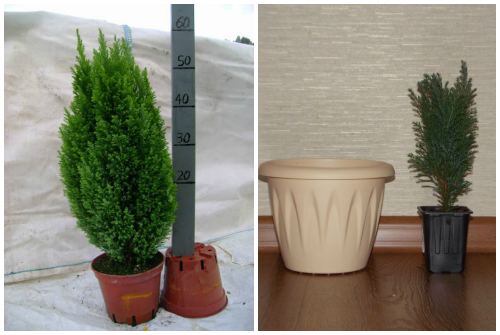

To your attention the transplant instruction:
- Take a slightly larger pot.
- Carefully transfer the tree from the old container to the new one, without disturbing the earthen coma.
- Do not deepen the root collar so as not to destroy the plant.
- Move Elwoody to the shade, reduce watering and resume only after the painful period has passed.
- Remember that cypress prefers fertile, loose and draining soil.
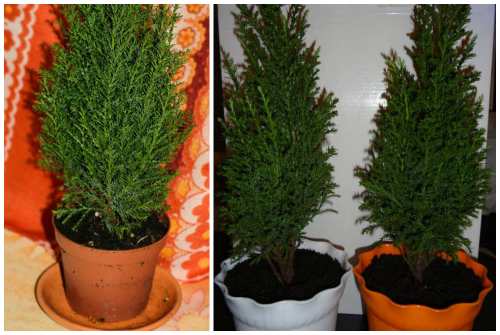

Landing
In order for the cultivation of a crop to be successful, you need to choose the right site for planting a tree. Cypress prefers to grow in well-lit, sunny places, or in partial shade... At the same time, the site must be protected from drafts and winds.
Important! Shrubs with yellow needles are best planted in sunny areas, and with green and blue needles in partial shade.
Cypress loves high air humidity, and therefore the ideal option would be planting near a reservoir.
The culture prefers fertile soil, with the addition of a significant amount of peat. Also, it will not be superfluous to add humus and sand. The soil must be water-permeable, since stagnant moisture is fraught with root rot.
Landing Elwoodi in open ground
A cypress in a pot can be moved to a plot.
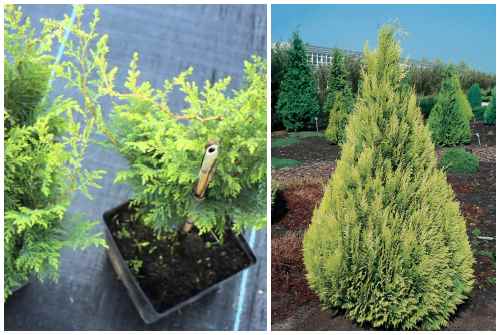

- Transplanting a plant into the ground is possible in April, when the earth has time to warm up after winter, but it is better to prepare a hole 90 cm deep and 20 cm wide for planting in the fall, so that the soil has time to “sit down”.
- At the bottom, place a layer of broken brick and sand 20 cm thick and add a mixture of turf, humus, peat and sand (3/3/2/1). During the winter, it will overheat and quickly heat up in the spring.
- Planting begins by watering the hole with water and a lump on the rootstock of the seedling with a root solution at the rate of 5 liters of water - 1 package of the product.
- Place the seedling in the center of the hole, and cover the soil in layers, mixing it with 300 g of nitroammofosk.
- After planting, the soil will settle, so position the seedling so that its root collar is 10-20 cm below the soil level. Water the entire planting. Top up the soil so that the neck is flush with it.
- Mulch the area around the cypress tree and tie it to a support.
- For the winter, just wrap the crown with non-woven fabric.
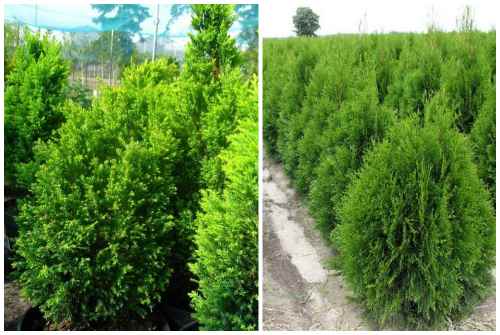

Shrub in landscape design
Conifers in principle, and Lawson's cypress in particular, are considered valuable crops in terms of landscape design. They look great in single plantings and flower arrangements or in flower beds next to roses (Figure 7).
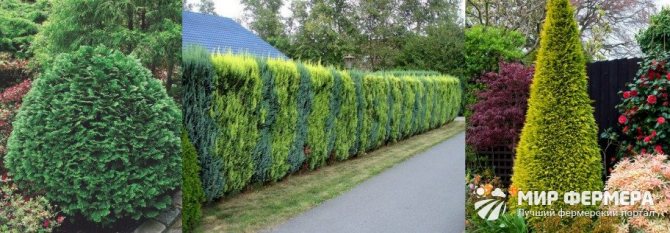

Figure 7. Coniferous plant is actively used in landscape design
In addition, with the help of a cypress tree, you can create a beautiful hedge. Most hybrid varieties have good winter hardiness and do not require special shelter for the winter, however, one should focus on the characteristics of a particular variety and the climatic conditions of the region. From the video you will learn how to prepare a cypress tree for winter.
Cypress diseases and their treatment
- Burn. Yellow and brown spots can appear from the sun and from fungus. The affected areas only need to be removed.
- Late blight rot appears due to increased moisture in the soil.
- Sooty fungus in the form of plaque appears due to poor ventilation and excessive humidity. It is treated with insecticides.
- Hairy lice and worms are immediately visible in the form of "cotton" bloom and stickiness. Appear due to excessive humidity and low temperatures. You can clean the plant by hand using a soapy solution and a sponge, followed by spraying with a solution of garlic and tobacco.
- Thuvaya mining moth. The larvae are poorly visible, do not exceed 3 mm in length. Shoots turn brown and fly around. You can see the gnawed holes of insects.


Care
The culture needs regular and abundant watering. In normal, not too hot weather, pour out for one plant, one bucket of water once a week... In hot weather, you will need to increase the number of waterings up to 2 times a week. In addition, in extreme heat, it is recommended to spray the plant.
The soil around the plant must be loosened regularly and weeds must be removed. Mulching of the soil is desirable. Peat or wood chips are suitable as mulch.
Cypress tolerates pruning, including shaping... It is advisable to prune the shrub two years after planting. Pruning is necessary in the spring. At the same time, old, dried branches are also removed. Pruning stimulates the growth of new shoots and also gives the plant a decorative appearance.
Plant growing reviews
Reviews about the features of growing a thorny coniferous plant are positive.
- Irina: I just love this decorative Christmas tree. I grow a plant on the street, cover the crown with a cloth for the winter, and decorate the tree with garlands for the New Year.
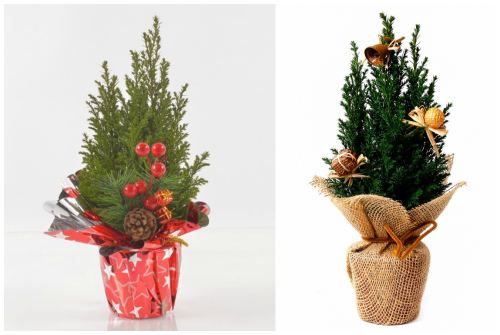

- Vladimir: Cypress Elwood is our pet. It is so dense and fluffy that it decorates our garden, being in the most prominent place.
- Olga: I thought it was an exclusively indoor cypress tree, but in winter it almost disappeared from me in a warm room. I had to take it out onto the balcony, and in the spring, plant it in the garden, choosing a shady spot. It still grows well in the open field, I protect it from frost for the winter, and in the summer I intensify the spraying of the crown.


This plant fell in love with Russian flower growers for its beauty and unpretentious care. Observing elementary rules, you can give a fluffy bush a long life. Have you had any experience with the cultivation of Elwoodi cypress? Share your experience in the comments.
Growing conditions and care procedures
Lawson's cypress trees are demanding and difficult to grow.Should grow in sunny or semi-shady areas, in warm, quiet places, protected from cold, drying winds. These plants are very sensitive to frost, planted in open and windy areas can freeze through. Therefore, they can only be grown in the warmest regions of the country.
They also require high air humidity, it is best to plant them near water bodies. They very badly tolerate drought, heat, scorching sun and dry air; strong, dried winds are also not favorable for them.
Lawson cypress trees prefer fertile soil, fairly moist but penetrating, with a slightly acidic or neutral pH value, calcareous soils are not suitable.
These plants do not need regular pruning, but they tolerate it very well. In addition, shearing affects the density of the plant.
Lawson cypress trees are very sensitive to air pollution and high soil salinity. Weakened plants can be susceptible to disease and pests. Fungal diseases (gray rot, late blight, diplodiosis) may appear. Cypress pests include: aphids, spider mites, scale insects.
We propagate Lawson's cypress trees only vegetatively, that is, by cuttings or grafting. We take seedlings in late summer or early spring and root them in peat, in a warm and humid environment (for example, in a greenhouse).
Top dressing
During the dormant period, in winter, cypresses are not fertilized. Top dressing is required from May to mid-autumn. For this cypress, a mineral fertilizer for ornamental plants is suitable. It is brought in once every two weeks, using half of the dose indicated on the package.
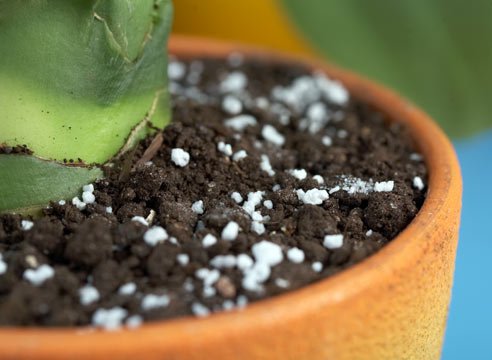

From May to August, the cypress must be fed with liquid mineral fertilizer for ornamental indoor plants, using only half of the recommended dose, or fertilizer for bonsai.
Growing cypress from seeds
Seed and vegetative propagation is possible.
In the fall, when the buds open, collect the seeds. Seeds are sown in February-March, but they must first be stratified (keep them for 2-3 months in the vegetable section of the refrigerator).
- Plant one seed at a time to a depth of 0.5-1 cm in a container of soil mixture for coniferous plants or a mixture of sand and sawdust.
- Cover crops with foil or glass, keep the air temperature around 24-25 ° C. Air the crops daily, moisten the soil as it dries, avoiding stagnant moisture.
- Good lighting is necessary to prevent the seedlings from getting sick or stretching, but protect crops from direct sunlight.
- As it grows, once a month, you can fertilize the conifers with fertilizers.
- Plants grow slowly, you need to be patient, and continue leaving with moderate watering.
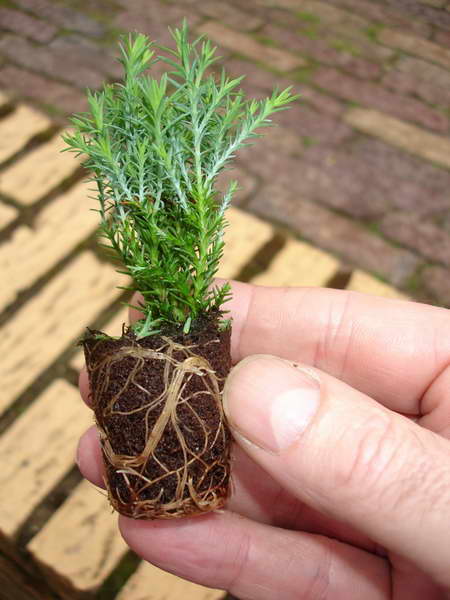

- The grown seedlings are transferred into permanent pots.
Where can one buy
You can buy seedlings in a hypermarket, gardening stores, and nurseries. It is best to purchase seedlings from nurseries. Some people prefer to order through online stores.
| Variety | Where can one buy | Price |
| Elwoody | Hypermarket OBI | 349 rubles |
| Elwoody Empair | Landscape Bureau "Svoya Usadba" | 450 rubles |
| Yvonne | Kennel "Besedinsky" (Kursk) | 400 rubles |
| Globoza | Agro (Moscow region, delivery within Russia) | 295 rubles |
| Blue Surprise | Agro | 390 rubles |
Reproduction and transplantation of a flower
It is possible to increase the number of cypress specimens by seed and vegetative (cuttings and using layering) methods. If necessary, it can be transplanted.
Sunflower seeds
The sequence of the seed propagation method is as follows:
- First, it is necessary to stratify the seeds so that they have better germination. To do this, fill the container with a light and nutritious substrate, place the seeds in it and take it outside under the snow. You can harden the seed in the refrigerator for 2-2.5 months.
- In spring, bring the container to a warm room (+ 18-22 ° C) with bright diffused light, where the seeds will germinate.
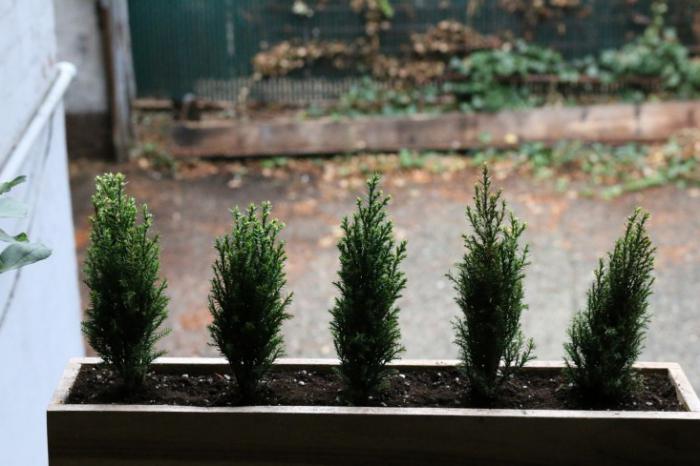

Seed propagation
- Slightly strengthened seedlings are systematically watered and periodically taken out into the open air (without drafts) so that they are tempered.
- If the crops are dense, then they need to dive.
- Transplant well-established plants into separate containers and create a small shadow for them.
Cuttings and branches
At the beginning of spring, young apical cuttings 10-15 cm long should be cut at an angle from the lateral shoots of the plant and buried with the lower part freed from needles into a mixture of perlite and sand or into another light substrate. Then ensure the content under a plastic wrap with a temperature of + 18-22 ° C and a humidity of at least 60% for 1.5-2 months. During this time, roots should form.


Cypress cuttings
The branch breeding method is usually used outdoors. The lower shoot must be pinned to the ground and treated with a growth stimulator. After a year, the layers can be cut off and transplanted.
Transplant technology
Many delicate roots force you to be sensitive to plant transplantation and not to carry out it unnecessarily. Without destroying the earthen lump, you need to carefully transfer the cypress from one container to another (there should already be drainage there) and fill all the voids with a loose substrate of leaf and turf soil with sand.
It is impossible to deepen the root collar. Then you should remove the pot with a tree in the shade, apply a root formation stimulator (for example, Epin). Frequent spraying of the crown will be required, but watering should be reduced until the shoots are straightened.
When is the best time to plant
If you are confident in the quality of the acquired planting material and have chosen a place in full accordance with the requirements, then the main thing is to choose the right time for planting. The soil should be well warmed up, so it is difficult to name the exact date, you will have to determine it yourself, taking into account the regional climate... For the middle zone, this is April and May - provided that there were no late frosts. Bird cherry cold (the time when bird cherry blossoms) does not count.
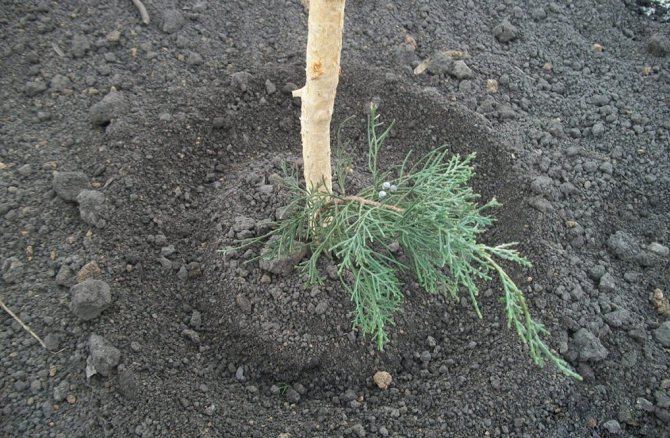

Heated soil is considered to have a homogeneous, ice-free structure, at a depth slightly greater than the bottom of the hole required for planting. Also, the site should already dry out and be freed from runoff water. But keep in mind that the preparation of the earth, nutrition, loosening and disinfection, you need to do in the fall.
Moscow suburbs
Among gardeners, fans of the cypress, the opinion has taken root that it is impossible to grow Lawson in the Moscow region. This version has at least two explanations. The first is the influx of fake planting material that flooded the markets about 10 years ago in the wake of a surge in interest in landscape art and in conifers in particular.
Did you know? The genuine Miraculous icon of the Mother of God is written on a cypress board. Due to the properties of this tree, insects do not attack it, so it was used for painting portraits of saints and iconostases.
Indeed, in early adolescence, it is almost impossible to distinguish the varietal cypress from the cheaper, and sometimes stimulant-depleted seedlings of other conifers. And gullible Muscovites brought from the garden collapses either a simple cypress, or even a small thuja. Naturally, they did not wait for the handsome man with exotic colored needles promised by the catalog.


Today, you can be sure of the quality of planting material if you contact nurseries., and it is not difficult to grow a cypress tree on your own from branches or seeds taken from the mother plant. The second reason for disappointment is more significant. Lawson really has a very specific mechanism of adaptation to temperature extremes, which the Moscow region is famous for. An adult healthy cypress tree easily tolerates a cold snap to -25 ° C, but not sharp and provided that the crown is tightly protected.
Other regions
In warmer regions, Lawson feels at ease and happily gains altitude.... For planting, it is only important to find loamy soil saturated with nutrients. This condition is mandatory, since one-time, even regular feeding, may not be enough for an evergreen plant. If you decide on a hedge or group formation, then the distance between the trees should be at least 1.5 m.
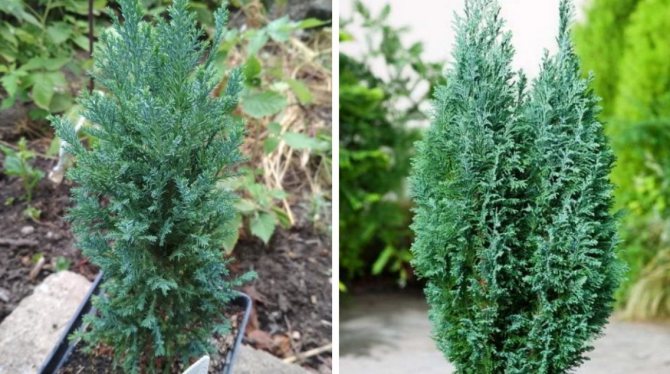

Is cypress afraid of disease?
Our cypress is a fairly strong plant that is resistant to diseases, and pests are almost not afraid of it. At home, it can be struck by a spider mite, but if the correct growing conditions are followed, then this pest is not terrible. Most often, cypress suffers from improper (over) watering when its roots rot.
Cypress Elwoodi is a welcome guest in homes, as it releases phytoncides that inhibit staphylococcal infection, E.coli and other pathogenic bacteria. In addition, it has excellent decorative properties, and for the New Year it may well pretend to be a living tree! Just try to care for your homemade cypress in a pot correctly and it will behave very well too.
How to propagate Elwoody
Lawson's cypress is propagated by seeds, cuttings and layering. Wherein:
- before sowing, the seeds must be stratified in the cold;
- Layers are taken in the spring from the branches of the lower tier, attaching them with hairpins to the ground and sprinkling them on top with a layer of earth, cut off the rooted shoot and transplanted to a permanent place in the fall;
- cuttings are harvested in spring from shoots cut into pieces, their rooting is faster in well-moistened light soils, transplanting is carried out in the next season.
Irrigation
In winter, the Elwoodi cypress needs to be irrigated moderately, make sure that there is no overdrying of the earthen coma, but there should also be no overflows. In summer, watering should be plentiful and regular, as should spraying. The cypress does not tolerate drying out of the soil and dry hot air and quickly dies.
- Water for irrigation cypress must be soft.
- It is good to use melt water for irrigation, in summer tap water can be boiled and cooled, all indoor plants love this water.
- Use a houseplant dispenser to avoid overflow.
- Ice cubes will also help you dose the watering.
- Water enters the ground as it melts, slowly, also managing to evaporate into the air.
Types and varieties of cypress with photos and names
Pea cypress Chamaecyparis pisifera
Very similar to a juniper. The crown is conical, scaly needles have a bright green color. The trunk is covered with reddish bark.
Varieties:
Boulevard is a cypress tree up to 5 m high. The crown is pin-shaped. The awl-shaped needles reach a length of 6 cm, have a bluish-silver color. Filifera is a crown in the form of a wide cone. Scaly needles, dark green color.
Pea cypress cultivar ‘Nana Aureovariegata’ photo
Nana - has a slow growth rate. At a height of about 60 cm, it can occupy a diameter of 1.5 m. The scale-like crown densely fills all the allotted space with branches.
Lawson's cypress Chamaecyparis lawsoniana
Lawson cypress Chamaecyparis lawsoniana photo
It has a crown in the form of a narrow cone, the lower branches slope towards the ground. The needles are short, green in color.
Varieties:
Lawson's cypress Chamaecyparis lawsoniana ‘Blue Surprise’ photo
Blue Seprise - has a blue shade of needle needles with a silvery sheen.
Lawson Fletcheri cypress Chamaecyparis lawsonaina Fletcheri photo
Flatchery - has a columnar crown shape, the branches are directed upwards. The needles are green or light blue.
Lawson's cypress Alumi Chamaecyparis lawsoniana 'Alumii'
Elwoodi - reaches a height of 3 m. The needles are blue in color.
Lawson's cypress Elwoodi Chamaecyparis lawsoniana Ellwoodii photo
Varieties of the Elwoodi variety: Gold, Pidzhmi, Pillar.
Not so long ago, plant lovers began to use Elwoodi cypress for planting. It belongs to conifers, and therefore the cultivation of this plant was previously considered unrealistic in the home. But, as recent observations show, if you take proper care of the crop, then it grows well, even if it is in a flower pot.
WATERING
The Elwoodi cypress needs regular watering with settled water. Try not to allow the soil to dry out, this rapidly destroys the plant and in the future it will be almost impossible to bring the tree back to normal. You can add a little peat to the soil, which makes it possible to water a little less often.
It may seem that all plants need to be hydrated a certain number of times each week. However, it is not. Each plant has its own watering requirements - it depends on the size of the plants, the size of the pot, the season, temperature and light, the quality of the soil and the moisture requirement inherent in a particular species. For example, on cloudy days the plant needs less moisture, but on sunny days it needs more water.
Plants need ample watering during the warmer summer months, and less water is needed in cooler weather. Even in stable conditions, a constant amount of water is not a guarantee of success, since the plant grows in size and, accordingly, the amount of water it needs increases.
Water more often and more abundantly:
- plants in clay pots;
- plants with large or thin leaves;
- plants with thin stems;
- plants during active growth;
- plants with a powerful root system;
- flowering plants;
- hanging stems;
- in the warm season and at high temperatures in the room;
- in bright light;
- in dry air;
- with open windows.
Less moisture required:
- plants in plastic pots;
- plants with thick leaves with a waxy bloom;
- leafless plants;
- plants with thick stems;
- dormant plants;
- newly transplanted plants;
- plants with a poorly developed root system;
- weak and emaciated plants;
- at low room temperature;
- on cloudy days or in low light;
- with high air humidity;
- in the absence of air movement in the room.
Cypress Elwoodi loves moisture; in the warm season, you need to carefully monitor so that the soil in the pot does not dry out. You should not pour the ephedra either, it is better to water it often and little by little. During the dormant period - from the end of October to March, watering is always reduced, especially if the cypress is on the loggia.
Moisten the soil only when the top layer is dry enough. The plant responds well to irrigation with melt water. Simply freeze the water in ice cube trays and place them a few each day on the soil around the plant. As the water melts, the water will gradually moisten the earth, and a small part of the moisture will evaporate, humidifying the air.


In winter, the Elwoodi cypress should be watered sparingly, make sure that the earthy coma does not dry out, but there should also be no overflows. In summer, watering should be plentiful and regular, as should spraying. The cypress does not tolerate drying out of the soil and dry hot air and quickly dies.
Water for irrigation cypress must be soft. It is good to use melt water for irrigation, in summer tap water can be boiled and cooled, all indoor plants love this water. Use a houseplant dispenser to avoid overflow. Ice cubes will also help you dose the watering. Water enters the ground as it melts, slowly, also managing to evaporate into the air.
Possible growing problems
Cypress trees are characterized by the following problems:
- root rot infection;
- drying out of branches;
- yellowing and falling of needles;
- spider mite attacks;
- harmful activity of the scale insect.
All of the above problems are the result of improper care of the ephedra.
Root rot appears when the plant often succumbs to waterlogging, as a result of which the roots are constantly in stagnation of moisture.
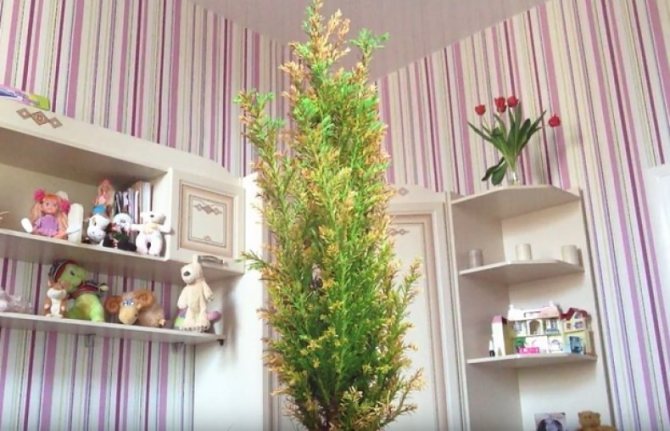

If you notice that the cypress tree looks unhealthy and after inspection you are convinced that there are no pests on it, try to dig up the plant and examine its roots. With a slight lesion, diseased roots are cut off, and the cut sites are treated with a fungicide.
Then the plant is transplanted into completely new soil and a new container. With a strong defeat, the ephedra will have to get rid of.
In case of sudden yellowing and falling of the needles, the plant should be carefully examined. If there is a spider web on the branches, then an infection with a spider mite has occurred. To get rid of it, you will need the use of chemicals - acaricides, which are allowed for spraying indoor crops.
The drying of the branches and the falling off of the needles also occurs when the scabbard attacks. With a slight infection from this pest, you can try to get rid of it mechanically - by scraping the sucking insect with a brush.
Also, at the initial stage of infection, treatment with a soap-oil solution can help. With a strong infection, you cannot do without chemistry. The drugs "Actellik", "Fosbecid" and others will help.
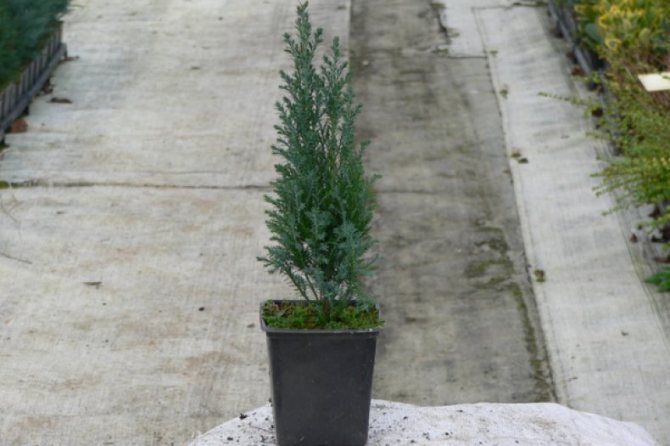

Having grown such a beautiful and original plant as Lavson Elwoodi's cypress, and carrying out its proper planting and care, you will get an amazing coniferous corner in the house and, in addition, a living Christmas tree for the New Year - this plant is most often used for such purposes in winter.
Transplant technology
For the favorable development of the plant, it is necessary to transplant it correctly, since the cypress is difficult to tolerate this procedure. The transplant should be performed only when the tree becomes too crowded, moving it into a container several centimeters larger, acting carefully.
In order for the Elwoodi cypress to be minimally damaged during transplantation, it must be moved to a new container along with an earthen lump. The plant should not be deepened too much. After the procedure, the pot must be placed in a shaded place and not watered for 10 days.

